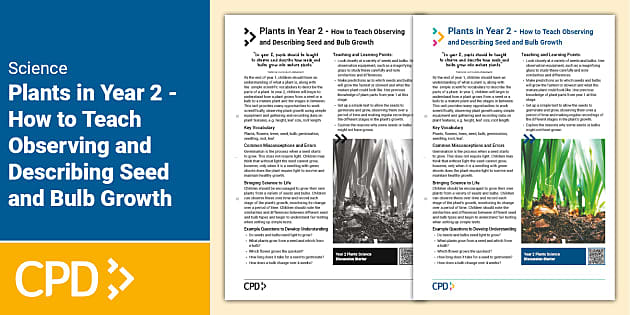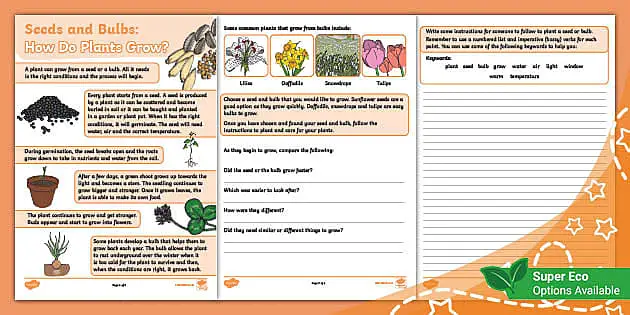Seeds and bulbs grow through a fascinating process. They transform from tiny structures into thriving plants.
Have you ever wondered how seeds and bulbs grow into beautiful flowers or fruitful plants? The journey begins with a small, seemingly lifeless seed or bulb. Once planted in the soil, they embark on an incredible transformation. Seeds need water, warmth, and the right conditions to sprout.
Bulbs, on the other hand, store energy and nutrients, ready to burst into life when the time is right. Understanding this process helps us appreciate the wonders of nature and the life cycle of plants. Join us as we explore the steps and conditions needed for seeds and bulbs to flourish. Let’s uncover the secrets behind their growth.
Introduction To Plant Growth
Seeds and bulbs are essential for plant growth. Seeds are small, often hard structures. They contain a tiny plant inside. Bulbs are underground storage organs. They store food for plants. Both need water, sunlight, and soil to grow. Seeds sprout and grow roots first. Bulbs produce shoots that grow upward. These processes are vital for plants.
Plants help clean the air. They provide oxygen. They offer shelter to animals. Plants also give food to many creatures. Seeds and bulbs are key parts of this. They ensure new plants grow. This keeps ecosystems healthy. Without them, many animals would struggle to survive.

Credit: www.twinkl.co.th
Seed Structure And Function
Seeds and bulbs grow by absorbing water, which activates their cells. This process allows them to sprout and develop into plants. Soil and sunlight further aid their growth.
Parts Of A Seed
Seeds have three main parts. The seed coat protects the seed. Inside, the embryo will grow into a new plant. The cotyledon stores food for the embryo. Each part is important for seed growth. Without them, the seed will not sprout.
Role In Plant Development
Seeds begin their life in soil. They need water to grow. The seed coat softens and opens. The embryo starts to sprout. Roots grow down into the soil. The stem grows upward. Leaves appear next. Each step is key for the plant. Plants need sunlight, water, and soil to grow strong.
Germination Process
Seeds need water, air, and the right temperature to grow. Without water, seeds stay dormant. Air is important too. Seeds breathe in oxygen. Temperature is key. Too cold or too hot, and seeds won’t sprout. Light can also matter. Some seeds need light, some need darkness. All these conditions must be right. Then, a seed can start to grow.
Germination happens in stages. First, the seed takes in water. This is called imbibition. The seed swells up. Next, the seed coat breaks open. A tiny root, called a radicle, comes out. The root grows down into the soil. Then, a shoot comes out. This shoot grows up toward the light. Leaves start to form. The seedling is now visible. Each stage is vital. The plant needs each step to grow strong.

Credit: seeds.ca
Bulb Anatomy And Purpose
Bulbs come in many types. Each type has a unique purpose. True bulbs have layers, like onions. Corms look like solid bulbs but are different. Tubers are thick and store food. Rhizomes grow sideways under the ground. Each type helps the plant survive.
Bulbs store energy. This energy helps the plant grow. Nutrients are stored in the bulb. The bulb uses these nutrients to grow leaves and flowers. This process happens each year. The stored energy is very important. It keeps the plant alive in winter. The bulb starts to grow when the weather is right.
Growth Cycle Of Bulbs
Bulbs rest during the dormancy period. They store energy for future growth. This period is crucial for bulb health. The soil should remain cool and dry. This helps the bulb prepare for the next stage.
Sprouting starts when the temperature warms up. The bulb uses stored energy to grow. Leaves and stems begin to emerge. Flowers soon bloom, showing bright colors. This is the most beautiful part of the cycle.

Credit: homesteadgardens.com
Environmental Factors
Seeds need sunlight to grow. Light helps them make food. Water is also crucial. It softens the seed coat. This allows the seed to sprout. Without water, seeds cannot grow. Bulbs need sunlight too. They grow best in sunny spots. Bulbs also need water to stay healthy.
Soil must be rich and loose for seeds. Good soil helps roots spread. Temperature affects seed growth. Warm soil makes seeds sprout faster. Bulbs also need good soil. They grow well in well-drained soil. Temperature is key for bulbs too. They need a cool period to bloom.
Human Influence On Growth
Farmers use special techniques to help seeds and bulbs grow. They choose the best soil. This helps plants get the right nutrients. They water plants at the right time. This prevents them from drying out. Farmers also use fertilizers. These give extra nutrients to plants.
Pest control is important too. It stops insects from harming the plants. Good practices lead to better growth. More food for everyone.
Conservation helps protect seeds and bulbs. People save seeds from strong plants. They store them in seed banks. This keeps seeds safe for the future. Bulbs are also stored carefully. Farmers plant them in the right season. This helps bulbs grow better.
Protecting the environment is key. Clean water and air help plants grow strong. Conservation ensures we have healthy plants for years to come.
Conclusion And Future Outlook
Understanding how seeds and bulbs grow can inspire future gardening projects. Observing their growth reveals nature’s incredible processes and potential.
Sustaining Plant Life
Seeds and bulbs are essential for plant growth. They need sunlight, water, and nutrients. Seeds grow into plants with roots and leaves. Bulbs are underground storage organs. They help plants survive harsh conditions. Both are crucial for sustaining plant life. We must protect our plants. They provide us with food and oxygen. Healthy plants mean a healthy planet.
Innovations In Botany
Botany studies help us understand plant life better. Scientists use new tools to study plants. Advanced techniques can improve plant growth. Research in genetics helps create stronger plants. These plants resist diseases better. Innovations in soil science also help. They improve nutrient absorption. More efficient farming methods save resources. These innovations ensure a sustainable future.
Frequently Asked Questions
How Do Seeds Start To Grow?
Seeds start to grow when they receive water, warmth, and the right soil. They germinate and sprout roots and shoots.
What Is The Process Of Bulb Growth?
Bulbs grow by storing nutrients and energy. When conditions are right, they sprout roots and shoots.
How Long Does It Take For Seeds To Sprout?
The time varies by plant type. Most seeds sprout within a week to a month.
Do Seeds Need Sunlight To Germinate?
Not all seeds need sunlight to germinate. Some require darkness, while others need light.
Conclusion
Seeds and bulbs grow with care and patience. They need water, light, and nutrients. Each plant has its own growth process. Understanding these steps helps in gardening. With a little effort, anyone can grow beautiful plants. Watch them bloom and thrive.
Gardening brings joy and connection to nature. So, start planting today. Enjoy the journey of growth and discovery.

My mission is to help you bring the beauty of nature indoors with expert advice, detailed plant care guides, and creative design ideas.





Leave a Reply